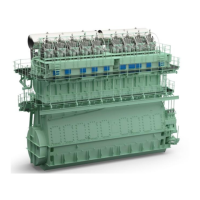Operation0240−1/A1
Winterthur Gas & Diesel Ltd.
2/ 3
6) Keep the correct scavenge air temperature downstream of the air cooler with the
usual water flow (see 0250−1 Operating Data Sheet). A higher scavenge air
temperature will give an unsatisfactory quantity of scavenge air in the cylinder.
This will cause more fuel to be used and higher exhaust gas temperatures.
7) Do a check of the scavenge air pressure decrease through the air cooler. Too
much resistance will cause a decrease of air to the engine.
Note: The fuel must be carefully cleaned before use. See the recommendations
in 0720−1 Fuel Treatment, Fuel System and the documentation of the
separator manufacturer.
8) Open the drain valves of all fuel tanks and and fuel filters regularly for short
periods to drain possible sludge or water.
9) Keep the fuel pressure correct downstream of the low pressure feed pump and
the inlet of the mixing unit (see the 0250−1 Operating Data Sheet and 0720−1,
paragraph 4, Configuration of the Fuel System).
10) Use the pressure retaining valve in the fuel return pipe to adjust the pressure at
the fuel pump inlet. The fuel will flow in the low pressure circuit of the engine at
the usual supply capacity of the booster pump.
The heavy fuel oil (HFO) must be sufficiently heated to make sure that its viscosity
upstream of the inlet to the fuel pumps is in the limits given in 0710−1, Viscosity
paragraph 3.1).
11) Do regular checks of the cylinder lubricating oil quantity that is used. Continuous
service will give the best cylinder lubricating oil quantity. Do not lubricate the
cylinders too much. For the usual quantity used, and how to calculate it, see
7218−2 Instructions about Measurement of the Cylinder Lubricating Oil
Consumption.
The cooling water pumps must operate at their usual flow capacity i.e. the supply
head is related to the given system configuration. The result of the flow rate and
temperature difference between the inlet and outlet will approximately relate to the
values given in 0250−1 Operating Data Sheet . If the temperature difference is too
much, repair or replace the related pump as soon as possible.
To adjust the correct supply head of the cylinder cooling water pump, the supply rate
must be controlled in the engine outlet manifold. There must always be positive
pressure at the suction side of the pump to prevent air flow through the stuffing box.
12) Make sure that the vents at the top of the cooling water spaces are kept
constantly open to release the air.
13) Do a check of the level in all water and oil tanks, and all the drainage tanks of the
leakage pipes. Look for unusual changes.
14) Look at the cooling water. If there is contamination or oil in the cooling water, the
cause must be found and the defect repaired.
15) Regularly examine the sight glasses of the condensate collectors to do a check
of the water flow (see 8345−1 Drainage System and Wash-water Piping System
Fig. 1, item 12). Clean the condensate collector and the orifices if necessary (see
Maintenance Manual 0380−1 and 6708−1).
16) If there is a pressure decrease, do a check of the oil filters. Clean the oil filters if
necessary.
17) You must monitor for a period, bearings that are replaced or bearings that are
installed after an overhaul. You must obey the precautions to prevent crankcase
explosions (see 0460−1).
18) Make sure that the covers of the rail unit are kept closed when the engine
operates.
2014
Usual Operation

